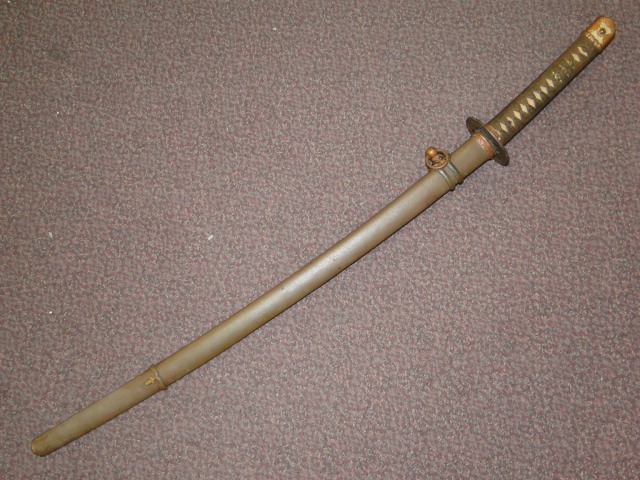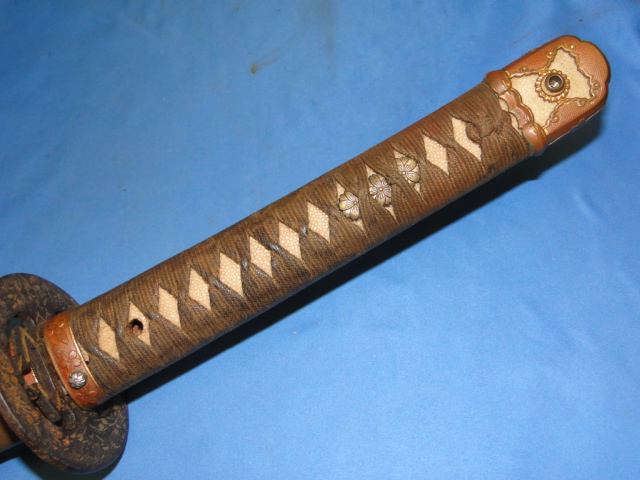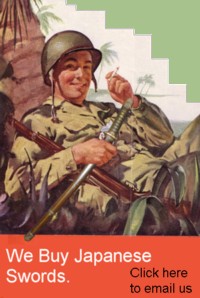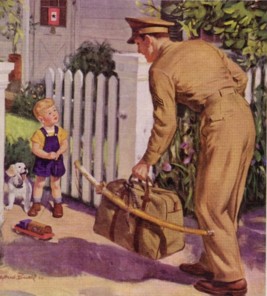SAMURAI SWORD 51 - KATANA BY MUNETOSHI
This is a Japanese Samurai katana sword. As created during WWII by master Munetoshi. This is a Gendaito, or
traditionally made blade. The fittings are all of the WWII period. The handle is nicely wrapped and has the
classical three flower Menuki on both sides.
The scabbard is the standard pine insert with a metal cover. Painted brown. With a single suspension ring. The
scabbard does not have any dents but it is missing the drag piece found at the tip of the scabbard.


|
The Samurai sword has a very rich history. The sword has been manufactured for several centuries and continues
to be produced today. The sword represented more than just a weapon. It was the soul of the Samurai warrior.
When attempting to identify the type of sword you have It is important to keep in mind that the fittings of
a sword (scabbard, handle, crossguard. etc.) may be identical from one sword to another. The reason why is
because during WWII the same fittings were used in all Army swords, Navy swords, etc. Armed forces are all
about uniformity. They strive to make everything the same.
This is the reason why a sword cannot be identified merely by its external appearance.
Understanding the different components that make up the Samurai sword is the first step in figuring out the
type of sword you have. That is the reason why we have created the
Understanding the Samurai sword section as a means to
provide a novice with the basic knowledge to start the path of determining the questions everyone has;
who made the sword, how old it is nad how much it is worth.
|

The sword has markings in both sides of the tang. One side has the date and period information, which is shown in the
following photograph.
The sword was made in the Showa period, which started in the year 1926. The Japanese dating system dictates that the
number of years after the start of the period be marked on the sword, 17 years because you subtract one, making the
year of production 1943.
The last component is the month of manufacturing. In this case the number 1 indicates January.

The following photograph shows a factory stamp next to a production number (508). This is an indication that even
Gendaitos can come from a mass produced factory. The tang has a single hole. The sword was never shorten.

The other side of the blade displays the Gendaito star and the signature of the master who made the sword, Munetoshi.

The following photographs show the entire length of the tang. Both sides. The end of the tang has an angled design.
The Habaki is the standard WWII type.


|
This page is a recognition and identification guide for Samurai swords.
Multiple detailed photos of a specific sample are provided. Descriptions point
out clearly defined points that should be noted.
One of the most commonly asked questions is "How much is my Samurai Sword worth?".
A price guide is included here to address this question. The value of the swords is
reviewed over a period of several years. A trend can be observed. The present worth
of the edge weapons in the collector's market is illustrated.
This service is provided free of charge to the visitor/enthusiast courtesy of
MilitaryItems.com,
a company dedicated to the preservation of military history and to providing quality
military antiques and collectibles to museums, institutions and the general public.
|
|



The upper section of the sword, near the base of the blade of one side, has what appears to be the hit from another sword.
The damage consists of a straight line approximatelly half inch in length. It is like a surgical cut created by another
blade. Must have been a considerable impact and was survived by the blade. A show of the strencth of a Gendaito.



|
WE BUY JAPANESE SWORDS - All types of Japanese edge weapons. Whether it is a WWII era Samurai sword or an
older type of blade.
The process gets started by you sending us an
Email .
We will respond to your inquiry normally within 24 hours and in many cases much faster.
We can tell you what you have, what it is worth and how much we can pay you.
One sword or an entire collection -
Email Us .
|
 |




The tsuba is an antique that has been modified for use with the WWII mounts. One side of the opening for the sword to
pass through (Nakago-Ana) has been cut to allow for the locking mechanism to pass. The Tsuba likely dates to the
early 1800's. It is gold inlaid but much of the inlay has been lost. Very interesting design.


By the Numbers
It is next to impossible to determine the exact number of Samurai swords that were produced and issued to
Japanese soldiers during the war. However, thanks to the record keeping maintained by the US Armed Forces,
it is possible to estimate how many swords were actually shipped home.
 |
There were over 500,000 Samurai swords were brought back home as souvenirs from the war.
There are several caviats to this number.
|
 |
For example, some soldiers took souvenirs and shipped them home circumbenting the established process.
Some of the swords were brought back inside duffle bags without anyone knowing except for the soldier who
captured the sword. This fact would clearly affect the final count.
The number also does not account for swords that were taken by Allied soldiers from other countries.
Collecting Samurai swords
Collecting Samurai swords is a field that has been growing since the days the GI's rummaged around Asia
bringing back military souvenirs. Japanese soldiers carried many of these swords when they went to
battle. Once the soldier was killed or captured, the Americans would take the edge weapons as war trophies.
Eventually all these pieces came back to the United States where military history enthusiasts began to collect them.
 |
In trying to determine if you should collect Samurai swords there are certain factors that should be
considered.
The adjacent table outlines some of the advantages and disadvantages of collecting the Samurai swords.
|
 |
This Samurai Sword may be currently reproduced.
It is becoming more difficult to be able to tell the fake ones from the real ones because
the quality of the reproductions is improving. The collector must become familiarized with
the construction style and materials employed in the manufacturing of this item.
Attention to the details is critical in order to be able to determine the authenticity of
the collectible.
If you have an interest is seeing other Japanese Samurai swords, you can do so by going to our
Japanese Samurai Swords Price Guide
identification guide. Where we cover Samurai swords from all periods.
| 




